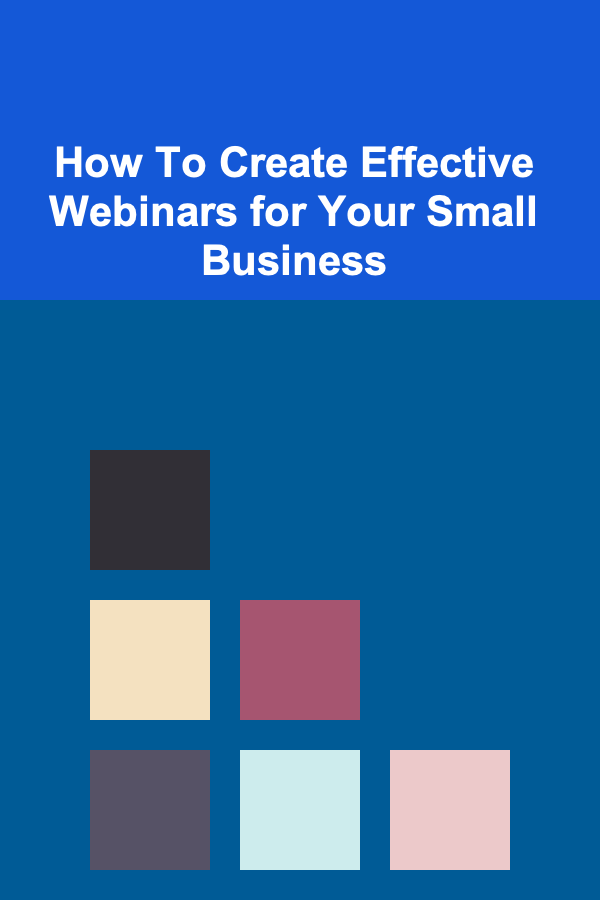
How To Create Effective Webinars for Your Small Business
ebook include PDF & Audio bundle (Micro Guide)
$12.99$7.99
Limited Time Offer! Order within the next:

In today's digital landscape, webinars have emerged as a powerful tool for small businesses to connect with their target audience, generate leads, establish authority, and ultimately drive sales. However, simply hosting a webinar isn't enough. To truly reap the benefits, you need to create webinars that are engaging, informative, and strategically aligned with your business goals. This comprehensive guide will walk you through the key steps involved in crafting effective webinars that deliver tangible results for your small business.
Defining Your Webinar Goals and Target Audience
Before you even think about content or technology, you need a clear understanding of what you want to achieve with your webinar and who you're trying to reach. This is the foundation upon which your entire webinar strategy will be built.
Setting Measurable Goals
Your webinar goals should be specific, measurable, achievable, relevant, and time-bound (SMART). Vague aspirations like "increase brand awareness" are not sufficient. Instead, consider these examples:
- Generate qualified leads: Collect contact information from a minimum of 50 attendees who fit your ideal customer profile.
- Drive product demos: Increase the number of demo requests by 20% within two weeks after the webinar.
- Boost sales: Generate $5,000 in revenue from webinar attendees within one month.
- Establish thought leadership: Secure 5 mentions in industry publications or blogs within three months after the webinar.
- Increase website traffic: Drive a 15% increase in website traffic from webinar attendees in the week following the event.
Clearly defined goals will guide your content creation, marketing efforts, and post-webinar follow-up.
Identifying Your Target Audience
Knowing your audience is crucial for tailoring your webinar content and marketing messages. Consider these factors when defining your target audience:
- Demographics: Age, gender, location, industry, job title, company size.
- Psychographics: Interests, values, pain points, challenges, motivations.
- Technical Proficiency: Their comfort level with technology and familiarity with webinar platforms.
- Prior Knowledge: Their existing understanding of the topic you'll be presenting.
Create a detailed audience persona to help you visualize your ideal attendee. Give them a name, a job title, and a backstory. Understanding their needs and desires will enable you to create a webinar that resonates with them on a personal level.
For example, instead of targeting "small business owners," you might target "Sarah, a 35-year-old owner of a local bakery who is struggling to increase her online sales and wants to learn how to use social media marketing effectively."
Choosing a Compelling Webinar Topic
The topic of your webinar is the primary driver of registration and attendance. It needs to be relevant, engaging, and address a specific need or problem that your target audience is facing. Avoid generic topics that are already widely covered.
Brainstorming Ideas
Here are some strategies for generating webinar topic ideas:
- Analyze your website analytics: Identify your most popular blog posts, pages, and keywords.
- Review customer feedback: Pay attention to common questions, concerns, and requests.
- Conduct keyword research: Use tools like Google Keyword Planner, SEMrush, or Ahrefs to identify relevant keywords with high search volume and low competition.
- Monitor industry trends: Stay informed about the latest developments in your industry and identify emerging topics.
- Survey your audience: Ask your existing customers or email subscribers what topics they'd like to learn more about.
- Examine competitor webinars: Analyze what topics your competitors are covering and identify opportunities to differentiate yourself.
Validating Your Topic
Once you have a list of potential topics, validate them by asking yourself these questions:
- Is there sufficient demand for this topic? Does it address a real need or problem for your target audience?
- Can you offer unique insights or perspectives on this topic? What makes your webinar different from others on the same subject?
- Is this topic aligned with your business goals? Will it help you achieve the desired outcomes?
- Do you have the expertise to speak confidently and knowledgeably about this topic?
Crafting a Catchy Title
Your webinar title is the first thing potential attendees will see, so it needs to be attention-grabbing and informative. Use strong keywords, highlight the benefits of attending, and create a sense of urgency or curiosity.
Here are some examples of effective webinar titles:
- "5 Secrets to [Achieve a Desired Outcome] Even If You're a Complete Beginner"
- "The Ultimate Guide to [Solving a Specific Problem] in [Your Industry]"
- "How to [Do Something] Without [Common Pain Point]"
- "Webinar: [Topic] -- Ask the Expert!"
- "[Number] Proven Strategies for [Achieving a Goal] in [Timeframe]"
Creating Engaging Webinar Content
High-quality content is the heart of a successful webinar. It should be informative, engaging, and tailored to your target audience's needs and interests. Avoid simply regurgitating information that can be easily found online.
Structuring Your Webinar
A well-structured webinar will keep your audience engaged and help them retain the information you're presenting. A typical webinar structure includes:
- Introduction (5-10 minutes): Welcome attendees, introduce yourself and your company, outline the agenda, and set expectations.
- Main Content (40-50 minutes): Present your main points in a clear, concise, and engaging manner. Use visuals, examples, and case studies to illustrate your points.
- Q&A (10-15 minutes): Answer questions from the audience. This is a great opportunity to address specific concerns and build rapport.
- Call to Action (5 minutes): Clearly state what you want attendees to do after the webinar (e.g., visit your website, download a free resource, schedule a consultation).
Using Visual Aids
Visual aids are essential for keeping your audience engaged and helping them understand complex information. Use a variety of visuals, such as:
- Slides: Use clear and concise slides with minimal text and plenty of visuals. Avoid overwhelming the audience with too much information on each slide.
- Images: Use high-quality images that are relevant to your topic and visually appealing.
- Videos: Incorporate short video clips to illustrate key points or provide testimonials.
- Graphs and Charts: Use data visualization to present statistics and trends in a clear and understandable way.
- Demonstrations: If possible, conduct live demonstrations of your product or service.
Incorporating Interactivity
Interactive elements can significantly boost audience engagement. Consider incorporating these techniques into your webinar:
- Polls: Ask attendees questions to gauge their understanding of the topic and gather feedback.
- Quizzes: Test attendees' knowledge with short quizzes.
- Q&A Sessions: Dedicate time to answering questions from the audience.
- Chat Box: Encourage attendees to ask questions and share their thoughts in the chat box.
- Hand-Raising: Use the hand-raising feature to call on attendees to speak.
- Breakout Rooms (for larger webinars): Divide attendees into smaller groups for discussions and activities.
Storytelling and Examples
People are more likely to remember information when it's presented in the form of a story. Use anecdotes, case studies, and real-life examples to illustrate your points and make your webinar more relatable.
Maintaining a Conversational Tone
Avoid reading directly from your slides. Instead, speak in a natural and conversational tone. Imagine you're having a conversation with a friend or colleague. Use humor and personal anecdotes to keep the audience engaged.
Choosing the Right Webinar Platform
Selecting the right webinar platform is crucial for ensuring a smooth and professional experience for both you and your attendees. Consider these factors when choosing a platform:
Features and Functionality
Make sure the platform offers the features you need to deliver an engaging and effective webinar. Key features to consider include:
- Screen Sharing: The ability to share your screen to present slides, demos, and other visuals.
- Audio and Video: High-quality audio and video capabilities.
- Interactive Features: Polls, quizzes, Q&A sessions, chat box, hand-raising.
- Recording: The ability to record the webinar for later viewing.
- Reporting and Analytics: Data on attendance, engagement, and lead generation.
- Integration with Marketing Tools: Integration with your email marketing platform, CRM, and other marketing tools.
Ease of Use
Choose a platform that is easy to use for both you and your attendees. A complicated platform can lead to technical difficulties and frustration.
Scalability
Select a platform that can accommodate the number of attendees you expect to have. Some platforms have limitations on the number of attendees, so make sure you choose one that can handle your needs.
Pricing
Compare the pricing plans of different platforms and choose one that fits your budget. Some platforms offer free trials or free versions with limited features.
Popular Webinar Platforms
Here are some popular webinar platforms to consider:
- Zoom Webinars: A popular and reliable platform with a wide range of features.
- GoToWebinar: A well-established platform with a focus on business webinars.
- Webex Events (formerly Socio): A comprehensive platform for virtual events, including webinars.
- Demio: A user-friendly platform designed specifically for webinars.
- Livestorm: A browser-based platform with a focus on simplicity and automation.
Promoting Your Webinar
Even the best webinar won't be successful if no one knows about it. Effective promotion is crucial for attracting attendees and achieving your goals. Use a variety of marketing channels to reach your target audience.
Email Marketing
Email marketing is a highly effective way to promote your webinar to your existing subscribers. Send a series of emails leading up to the event, highlighting the benefits of attending and providing registration information.
Your email sequence should include:
- Announcement Email: Introduce the webinar and its topic.
- Benefit-Driven Emails: Highlight the key benefits of attending.
- Speaker Bio Email: Introduce the speaker(s) and their expertise.
- Reminder Emails: Send reminder emails a few days before the event, the day before, and the morning of.
- Last Chance Email: Send a final email a few hours before the webinar to encourage last-minute registrations.
Social Media Marketing
Use social media to reach a wider audience and promote your webinar to potential attendees. Share engaging content, run targeted ads, and participate in relevant online communities.
Consider these social media strategies:
- Create visually appealing graphics and videos: Use eye-catching visuals to grab attention.
- Share snippets of your webinar content: Give potential attendees a taste of what they can expect.
- Run targeted ads: Target your ads to reach specific demographics and interests.
- Use relevant hashtags: Use hashtags to increase the visibility of your posts.
- Engage with your followers: Respond to comments and questions promptly.
Website Promotion
Promote your webinar on your website by creating a dedicated landing page. The landing page should include:
- A compelling headline: Grab attention and highlight the benefits of attending.
- A clear description of the webinar: Explain what attendees will learn.
- Speaker bio(s): Introduce the speaker(s) and their expertise.
- A registration form: Make it easy for people to register.
- Social sharing buttons: Encourage people to share the webinar with their networks.
Also, consider adding a banner or popup on your website to promote the webinar.
Partner Marketing
Collaborate with other businesses or organizations in your industry to promote your webinar to their audiences. This can be a great way to reach a new and relevant audience.
Consider these partner marketing strategies:
- Cross-promotion: Promote each other's webinars to your respective audiences.
- Guest speaking: Invite a guest speaker from another organization to participate in your webinar.
- Joint marketing campaigns: Collaborate on a marketing campaign to promote the webinar.
Paid Advertising
Consider using paid advertising to reach a wider audience and drive registrations. Platforms like Google Ads, Facebook Ads, and LinkedIn Ads allow you to target specific demographics and interests.
Delivering a Polished and Professional Webinar
On the day of the webinar, it's crucial to deliver a polished and professional presentation. Preparation and practice are key to success.
Technical Preparation
Test your equipment and internet connection beforehand to ensure everything is working properly. Check your microphone, camera, and screen sharing capabilities.
- Do a dry run: Practice your presentation to get comfortable with the flow and timing.
- Close unnecessary programs: Close any programs that might interfere with the webinar.
- Disable notifications: Disable notifications to avoid distractions.
- Have a backup plan: Have a backup plan in case of technical difficulties.
Presentation Skills
Practice your presentation skills to ensure you deliver a clear, concise, and engaging presentation.
- Speak clearly and concisely: Avoid using jargon or technical terms that your audience may not understand.
- Maintain eye contact: Look directly at the camera to maintain eye contact with the audience.
- Use hand gestures: Use hand gestures to emphasize your points and keep the audience engaged.
- Vary your vocal tone: Vary your vocal tone to keep the audience interested.
- Be enthusiastic: Show enthusiasm for your topic.
Managing the Webinar
During the webinar, manage the technical aspects and engage with the audience.
- Start on time: Start the webinar on time to respect attendees' schedules.
- Welcome attendees: Welcome attendees as they join the webinar.
- Monitor the chat box: Monitor the chat box for questions and comments.
- Answer questions: Answer questions from the audience in a timely manner.
- Moderate the discussion: Moderate the discussion to keep it on topic and prevent inappropriate comments.
Following Up After the Webinar
The webinar doesn't end when the presentation is over. Following up with attendees is crucial for nurturing leads, driving sales, and achieving your goals.
Sending a Thank You Email
Send a thank you email to all attendees within 24 hours of the webinar. The email should include:
- A thank you message: Express your gratitude for their attendance.
- A link to the recording: Provide a link to the webinar recording.
- A link to the slides: Provide a link to the slides from the presentation.
- A call to action: Encourage attendees to take the next step.
- Contact information: Provide your contact information for follow-up questions.
Nurturing Leads
Nurture leads by sending them relevant content and offers. Segment your leads based on their interests and engagement during the webinar.
Consider these lead nurturing tactics:
- Send a series of follow-up emails: Provide valuable content and information related to the webinar topic.
- Offer exclusive discounts or promotions: Incentivize leads to make a purchase.
- Invite leads to a demo or consultation: Provide personalized support and guidance.
- Share case studies or testimonials: Showcase the success of your products or services.
Analyzing Results
Analyze the results of your webinar to determine its effectiveness and identify areas for improvement. Track key metrics such as:
- Registration rate: The percentage of people who registered for the webinar.
- Attendance rate: The percentage of people who attended the webinar.
- Engagement rate: The level of engagement during the webinar (e.g., poll participation, chat activity).
- Lead generation rate: The number of leads generated from the webinar.
- Conversion rate: The percentage of leads who converted into customers.
Use this data to refine your webinar strategy and improve your future webinars.
Overcoming Common Webinar Challenges
Even with careful planning, webinars can present challenges. Being prepared for these common issues and having solutions in place will ensure a smoother and more successful experience.
Technical Difficulties
Technical issues are inevitable, but minimizing their impact is key. This includes:
- Audio Problems: Invest in a good quality microphone and test it thoroughly beforehand. Use headphones to prevent echo. Have a backup microphone available.
- Video Problems: Ensure adequate lighting and a clean background. Test your camera settings. Have a backup camera or be prepared to present with audio only.
- Internet Connectivity Issues: Use a wired internet connection whenever possible. Inform family members or housemates to avoid heavy internet usage during the webinar. Have a mobile hotspot as a backup connection. Consider pre-recording parts of the webinar to play if your connection drops.
- Platform Glitches: Choose a reliable webinar platform and familiarize yourself with its features. Have a technical support person available to troubleshoot issues.
Low Attendance
Low attendance can be discouraging, but it doesn't necessarily mean your content is bad. Consider these factors:
- Poor Promotion: Review your marketing efforts. Are you reaching your target audience? Are your messages compelling? Experiment with different promotional channels and messages.
- Timing Issues: Analyze your audience's availability. Are you hosting the webinar at a convenient time for them? Consider different time zones.
- Registration Process: Is the registration process easy and straightforward? Minimize the number of required fields.
- Lack of Perceived Value: Does your webinar title and description clearly convey the value of attending? Make sure attendees understand what they will gain.
Lack of Engagement
Keeping attendees engaged throughout the webinar is crucial. Here's how to combat low engagement:
- Monotonous Presentation Style: Vary your vocal tone, use humor, and tell stories to keep the audience interested.
- Lack of Interactivity: Incorporate polls, quizzes, Q&A sessions, and chat activities to encourage participation.
- Irrelevant Content: Ensure your content is relevant to your target audience's needs and interests.
- Technical Difficulties: Technical issues can disrupt the flow of the webinar and lead to disengagement. Address technical issues quickly and efficiently.
Negative Feedback
Receiving negative feedback can be disheartening, but it's an opportunity for improvement. Consider these steps:
- Don't Take It Personally: Try to remain objective and focus on the specific criticisms.
- Analyze the Feedback: Identify the root cause of the negative feedback. Was it related to the content, presentation style, or technical issues?
- Address the Issues: Take steps to address the issues raised in the feedback. This might involve revising your content, improving your presentation skills, or investing in better technology.
- Respond Professionally: Respond to the feedback in a professional and constructive manner. Acknowledge the concerns and explain what steps you are taking to address them.
Conclusion
Creating effective webinars for your small business requires careful planning, engaging content, strategic promotion, and consistent follow-up. By following the steps outlined in this guide, you can create webinars that attract your target audience, generate leads, establish authority, and drive sales. Remember to continuously analyze your results and refine your approach to maximize the impact of your webinars and achieve your business goals. Webinars are a powerful tool -- use them wisely!

How to Respond to a Home Security Breach Effectively
Read More
How to Soundproof a Home Gym for Quiet Workouts
Read More
How To Track Your Language Learning Progress
Read More
How to Create Passive Income Streams for Nomad Life
Read More
How To Create a System for Idea Capture
Read More
Protecting Riparian Zones for Wildlife: A Comprehensive Guide
Read MoreOther Products

How to Respond to a Home Security Breach Effectively
Read More
How to Soundproof a Home Gym for Quiet Workouts
Read More
How To Track Your Language Learning Progress
Read More
How to Create Passive Income Streams for Nomad Life
Read More
How To Create a System for Idea Capture
Read More